Menu
An antique wardrobe is useful and substantial piece of furniture. We stock only quality 2 door, 3 door, 4 door antique wardrobes and linen presses, but also of more unique and unusual design, in mahogany oak and burr walnut. Each Victorian wardrobe is lined with fabric inside, creating clean and practical storage. Every antique wardrobe splits into sections enabling easy transportation and assembling at home.
Showing all 8 results
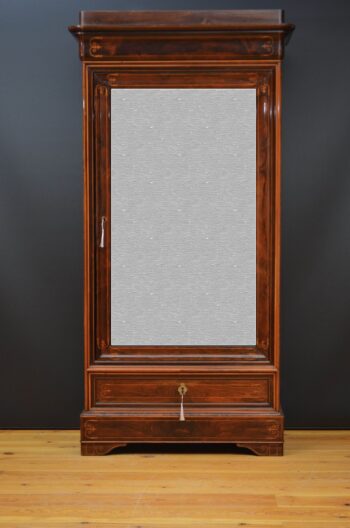

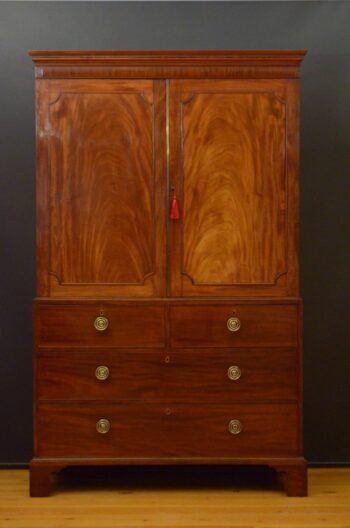
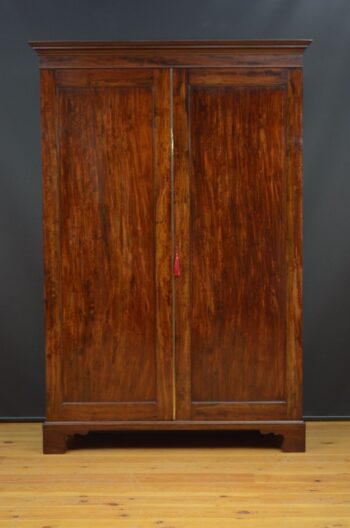
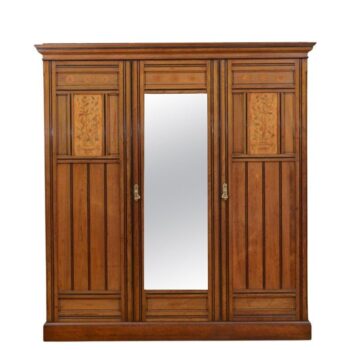
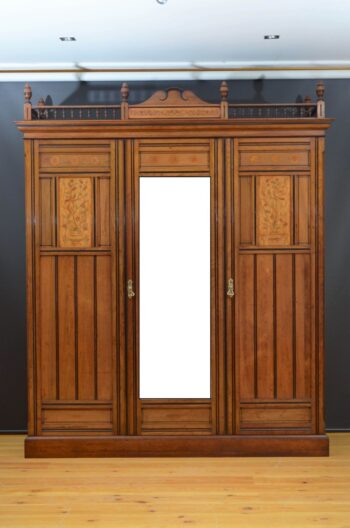
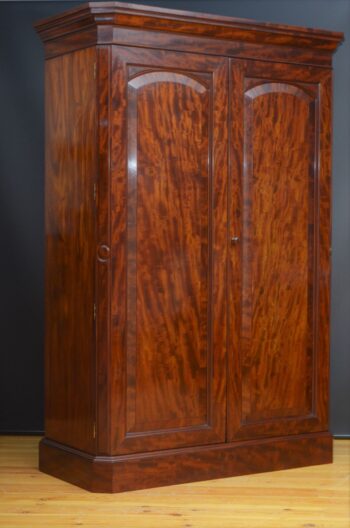
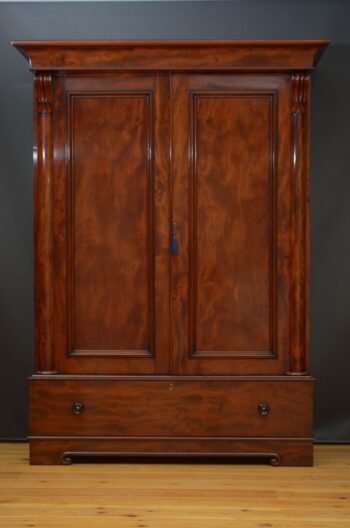
From classic children’s stories to ornate, elegant armoires designed for royalty, wardrobes have been a popular medium for artistic expression for generations. But what we consider a modern wardrobe is vastly different from what these unique and attractive pieces of furniture looked like in the past. Evolving from a simple chest of drawers, wardrobes are a combination of old-world charm and modern sensibility.
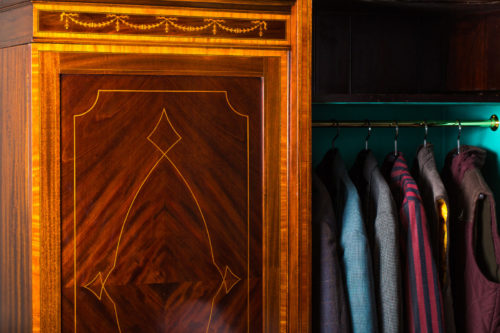
From elegant yet straightforward mid-century furniture to authentic antique Victorian and Edwardian pieces, wardrobes have been a staple in households across Europe since the 17th century and a luxury furniture item in medieval times and onward. We’ve covered all you need to know about the history of antique wardrobes, their origins, and even the meaning behind the name below.
While the average household in the middle ages had shelving or chests to store clothing and cloths, those with greater fortune were more likely to search for attractive, functional, and expensive furniture to keep their delicate clothing. Both armoires and wardrobes – two sides of the same coin – were created to fulfil this need. But while we consider both items as furniture pieces in their own right, the origin of their name means something slightly different.
The word wardrobe also originates from the Old French ‘wardereube’, meaning to guard garments. When built-in storage and closets were a rarity, wardrobes were considered an ideal place to keep precious items, jewels, and valuable pieces – and many came with a lock as a result. King Henry III even went as far as naming his household treasurer as the wardrobe keeper as part of his duties.
In a time where an abundance of rooms was the norm in a high-end household, an armoire or wardrobe would be considered a complete room of its own – similar to how a closet is a built-in room within a room in the modern household. Both armoire and wardrobe take their roots from specific rooms: A room where clothing is stored in the case of the wardrobe and a room where armour is stored in the case of the armoire.
While it may be surprising, many of the earliest examples of antique hanging cupboards – the ancestor of the modern wardrobe – were exported from America to England in the early 1700s. With a large scale, extensive carving and solid wood construction, these luxury furniture pieces provided clothing storage via a range of drawer sizes, like a modern cupboard or sideboard.
As multitudes of rooms became less of a staple, the concept of rooms for clothing was translated into chests of drawers, unique furniture, and a version of the wardrobes we know today. But while we can hang clothing in most modern wardrobes, more classic examples of this piece of furniture didn’t feature the same current system.
Instead, early 17-1800s wardrobes often featured doors opening onto a set of shelves, with drawers in the base for additional storage. It was only a select few lavish pieces that included extra wings for hanging a select few pieces of clothing in the Gregorian era. Wardrobes were often referred to as linen presses during this period. While still incredibly functional, the average home didn’t require the extensive hanging space we do for modern wardrobes, allowing for multi-purpose storage of clothing, shoes and more.
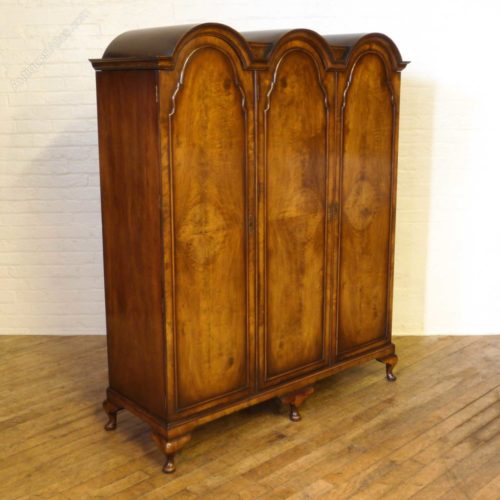
Wardrobes began to move into bedrooms and dressing spaces where they were more visible. At this point, it became even more important to create furniture pieces that were as nice to look at as they were functional. Stylish wardrobes ranged from expensive and high-quality woods to the inclusion of mirrors and even intricate carvings and gold leaf designs in the case of expensive pieces.
As a focal point, armoires and wardrobes became increasingly more decorated. French pieces, particularly, were adorned with columns, paintings, and extensive carvings to create pieces of artwork that were dramatic and eye-catching. While these armoires became smaller and slighter following the Renaissance, the quality and eye for detail remained for many years.
As wardrobes became more of a household essential, more designs with legs also began to appear, offering an alternative to designs that were flush to the ground. Varnish, lacquer, shellac and even oil or wax were used to finish off these attractive decorative pieces, and frequent polishing and care were required to keep them in perfect condition.
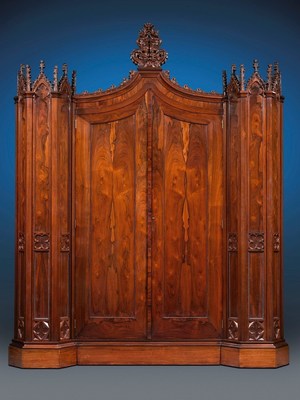
The long and fascinating history of antique wardrobes is what attracts many to this style of furniture. As one of the best examples of furniture pieces that can be identified to an era by design, wardrobes can say a huge amount about the tastes and preferences of a particular time. Some of the most common and popular historic antique wardrobe designs you may encounter include:
One of the most sought-after antique eras, the elegant and delicate style that characterises Queen Anne antique wardrobes appeal to many. Originating in 1701 through to 1750, these curved and stylised pieces and usually created from lighter and brighter woods. Walnut, maple, and cherry are all common choices, while a unique domed roof and stylised panel makes this style of design unmistakeable.
With a history spanning more than a century from 1714-1830, Georgian antique wardrobes fall across a spectrum of inspirations and styles, from Rococo to Barque. With simple, classic, and solid symmetrical designs that mimicked popular architectural choices, these sturdy and bulky items are an excellent example of robust furniture that can withstand the effects of time. Darker woods like mahogany were a popular choice, and panelled doors with simple drawers and winged hanging spaces were all tell-tale signs of these wardrobe pieces.
As part of the Georgian timeline, these exotic and heavily inspired Regency antique wardrobes went against the classic and solid trends adored by many from 1811-1820. Instead, styles from India, Japan, Turkey and even Persia were combined to create a less traditional final look. While these wardrobes were often designed from the same mahogany, the style of construction and difference in panelling and flourishes set Regency pieces apart.
Dramatic revival styles were the order of the day in the antique Victorian era from 1837-1901. Anything from Gothic to Greek to Renaissance returned to the scene, adding extra attention to detail and grandeur to create incredibly intricate designs. Victorian wardrobes are among the most accessible vintage furniture pieces to find and vary significantly in quality and style. The introduction of mirrors and the dawning of machine-created wardrobes make wardrobes more accessible than ever. At the same time, high-end and intricate hand-carved pieces were owned by the wealthy elite.
The Edwardian antique era from 1901-1910 saw the beginning of the modern wardrobe take form. With simple, classic lines, a lighter design and a no-frills approach, these furniture pieces have minimal details and less of the flamboyance of some revival Victorian designs. The early influence of Art Nouveau can be seen in many Edwardian pieces in terms of panelling, fixtures, and fittings.
With the Edwardian antique wardrobes paving the way to modern-day designs, we have since created a wide array of current wardrobe trends to suit a wide variety of current trends and preferences. From the ’50s mid-century modern to today’s mirrored designs, we can see the considerable inspiration that antique wardrobes have had on today’s bedroom furniture.
Up until the Victorian era, all wardrobes were crafted and finished by hand. That’s an impressive level of quality and longevity, proven by the excellent condition of many of these antique pieces. Whether you’re looking to collect unique, antique furniture for your own home or you’re buying with the hope of restoring life into old pieces; wardrobes are an excellent place to start.
With hundreds of different unique styles and eras, antique wardrobes and antique chests of drawers offer the ideal way to provide functionality without sacrificing individual style. At Nimbus Antiques, we supply exceptional antique furniture sourced across the UK. If you’re interested in adding an antique Edwardian wardrobe or Victorian armoire to your home, our expert team are the people to call – or view our range of antiques in stock online today.
| Cookie | Duration | Description |
|---|---|---|
| cookielawinfo-checbox-analytics | 11 months | This cookie is set by GDPR Cookie Consent plugin. The cookie is used to store the user consent for the cookies in the category "Analytics". |
| cookielawinfo-checbox-functional | 11 months | The cookie is set by GDPR cookie consent to record the user consent for the cookies in the category "Functional". |
| cookielawinfo-checbox-others | 11 months | This cookie is set by GDPR Cookie Consent plugin. The cookie is used to store the user consent for the cookies in the category "Other. |
| cookielawinfo-checkbox-necessary | 11 months | This cookie is set by GDPR Cookie Consent plugin. The cookies is used to store the user consent for the cookies in the category "Necessary". |
| cookielawinfo-checkbox-performance | 11 months | This cookie is set by GDPR Cookie Consent plugin. The cookie is used to store the user consent for the cookies in the category "Performance". |
| viewed_cookie_policy | 11 months | The cookie is set by the GDPR Cookie Consent plugin and is used to store whether or not user has consented to the use of cookies. It does not store any personal data. |